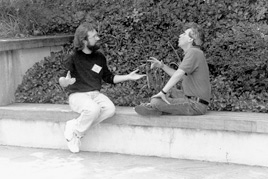1997: Pattern Formation During Development, Vol. LXII
Organizer: Bruce Stillman
One of the great scientific accomplishments of the past decade was the recognition that the mech¬anisms used for patterning of tissues and organs during development are remarkably similar among species. What works for flies and frogs also serves human beings very well as embryos acquire their form and identity. To celebrate these marvelous discoveries, the 62nd Symposium in this series fo¬cused on pattern formation during development, with a particular emphasis on evolutionarily con¬served mechanisms and molecules.
This outstanding series of meetings began in 1933, in the midst of economic depression. Each meeting lasted for 5 weeks while scientists were in residence at Cold Spring Harbor, and there were no time limits on the length of presentations or discussions. This "experiment in scientific proce¬dure," reflecting the apparent tranquility of academic life in those days, lasted for 8 years. The sec¬ond Symposium, entitled Aspects of Growth, included several papers dealing with differentiation and development.
For the 1941 Symposium, the new Director of the Laboratory, Milislav Demerec, condensed the program into 2 weeks, and his second Symposium focused on The Relation of Hormones to Devel¬opment, with 17 presentations. In 1948, Demerec changed the meeting to 8 days, held in early June, and this has been the arrangement until this year. Given the dramatic changes in the pace of scientific discovery in the biological sciences, the modern methods for rapid dissemination of information, and the fact that in many families, both spouses have demanding careers, scientists find it difficult, if not impossible, to spend more than a week at a meeting, Thus, I have shortened the program to 5 days, still considered by some to be a long time for a meeting. This was done after much thought, keeping in mind the goals of this particular series and indeed of all the meetings at Cold Spring Harbor Lab¬oratory. The idea is not to present a series of observations from a collection of individuals, but to pro¬vide sufficient time during the meeting for the experts in a field of biology to discuss the issues of the day and to determine how progress might be accomplished.
During 8 days in 1954, the Symposium focused on The Mammalian Fetus: Physiological Aspects of Development. The science was descriptive, but some ideas presented were the forerunners of the modern approaches to understanding development. Salome Glueckshon-Waelsch discussed the T (Brachyury) locus and a genetic approach to understanding development that foreshadowed the pow¬erful approaches to come. Then after a long hiatus between Symposia on this topic, Joe Sambrook or¬ganized in 1985 the 50th Symposium on the Molecular Biology of Development. The Symposium celebrated the conversion of developmental biology from a descriptive, anatomically based science to a mechanism-driven science of great interest.
In the dozen years since, we have learned much about the exquisite mechanisms that specify de¬velopment, but most importantly, the evolutionary conservation of the pathways that govern devel¬opment has emerged. We are no longer bound by technology, as in the early days of these Symposia, and modern technology has taken us to new heights unimagined even 12 years ago.
The field of developmental biology is now very large, and coupled with the decision to shorten the program, the inevitable difficult decisions about the selection of speakers and topics had to be made. I would have liked to include the important topic of imprinting, for example, but perhaps this could be the topic of its own Symposium in the near
| 
future. I thank Brigid Hogan and Gerry Rubin for much valuable advice and help with the scope of the meeting and potential speakers. The formal scientific program consisted of 64 oral presentations and a remarkable 233 poster presentations, and the meet¬ing attracted 391 participants. Introductory talks on the first evening were given by Mario Capecchi, Brigid Hogan, Roel Nusse, and Gail Martin, and the Reginald G. Harris Lecture was presented by John Gurdon. Sean Carroll presented a fascinating Dorcas Cummings Lecture to visiting scientists and the local community on the formation and evolution of animal body patterns.
Essential funds to run this meeting were obtained from the National Institute of Child Health and Human Development and the National Institute of Neurological Disorders and Stroke, both branches of the National Institutes of Health. In addition, financial help from the Corporate Sponsors of our meetings program is essential for these Symposia to remain a success and we are most grateful for their continued support. These sponsors are: Alafi Capital Company; Amgen Inc.; BASF Bioresearch Corporation; Becton Dickinson and Company; Boehringer Mannheim Corporation; Bristol Myers Squibb Company; Chiron Corporation; Chugai Research Institute for Molecular Medicine, Inc.; Di¬agnostic Products Corporation; The Du Pont Merck Pharmaceutical Company; Forest Laboratories, Inc.; Genentech, Inc.; Glaxo Wellcome Inc.; Hoechst Marion Roussel; Hoffmann-La Roche Inc.; Johnson & Johnson; Kyowa Hakko Kogyo Co., Ltd.; Life Technologies, Inc.; Eli Lilly and Company; Merck Genome Research Institute; Novartis Pharma Research; OSI Pharmaceuticals, Inc.; Pall Cor¬poration; The Perkin-Elmer Corporation; Applied Biosystems Division; Pfizer Inc.; Pharmacia & Upjohn, Inc.; Research Genetics, Inc.; Schering-Plough Corporation; SmithKline Beecham Pharma¬ceuticals; Wyeth-Ayerst Research; and Zeneca Group plc.. Plant Corporate Associates are American Cyanamid Company; Kirin Brewery Co., Ltd.; Monsanto Company; Pioneer Hi-Bred International, Inc.; and Westvaco Corporation.
I thank the staff, including Diane Tighe and Mary Smith, in our meetings and courses office under the talented direction of David Stewart, for their efficient and outstanding organization of this meet¬ing. Mary Horton and Wendy Crowley handled the various grant applications, and Herb Parsons and his staff provided flawless audiovisual assistance. The organization of this meeting relied on great help from my assistant Delia King. It was again a pleasure to work with the Laboratory Press, under the direction of John Inglis, particularly Dorothy Brown and Joan Ebert.
— Jan A. Witkowski |